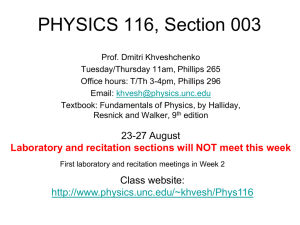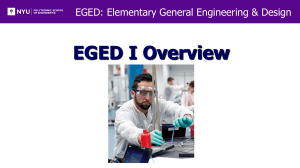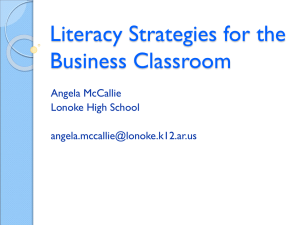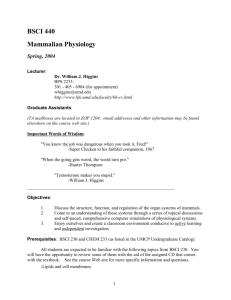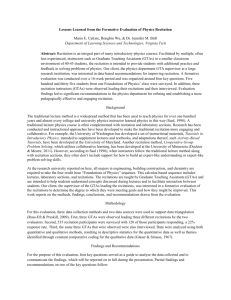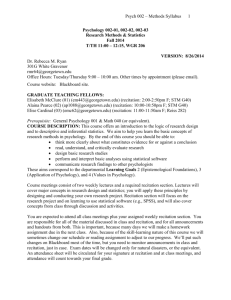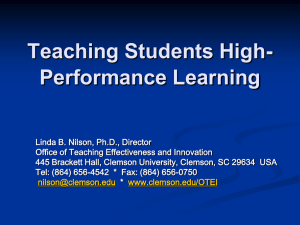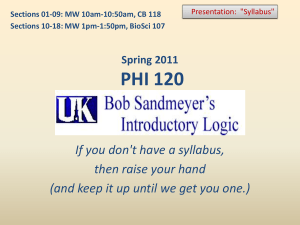student-active breaks - Innovative Educators
advertisement
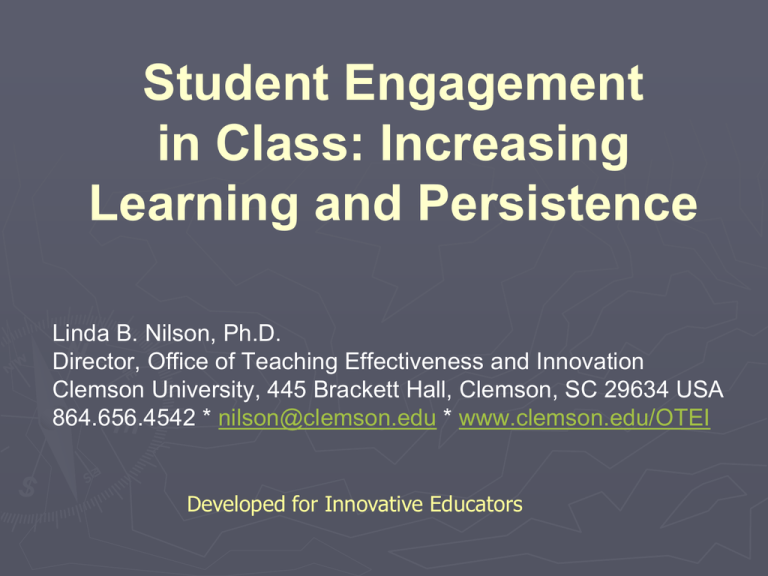
Student Engagement in Class: Increasing Learning and Persistence Linda B. Nilson, Ph.D. Director, Office of Teaching Effectiveness and Innovation Clemson University, 445 Brackett Hall, Clemson, SC 29634 USA 864.656.4542 * nilson@clemson.edu * www.clemson.edu/OTEI Developed for Innovative Educators Participant Outcomes ► By the end of this webinar, you will be able to plan and manage your classes to gain and maintain your students’ attention and engagement, thereby enhancing their motivation, learning, retention of the material, and persistence in college. The engagement techniques reviewed here will also enhance students’ satisfaction with your course and your teaching. How do you decide what to do in class ? ► By your student learning outcomes = what you want your students to be able to do by the end of the class or week. ► Activities & Assignments (in-class, homework) = Their Learning Experiences = Your Teaching Methods Choose the best tools (methods) for the job (outcomes). Lecture when you want to: ► Pique students’ curiosity, inspire, motivate ► Model style of thinking, problem solving ► Give unique organization to the material ► Adapt high-level material to students’ level ► Add your own viewpoint or related research ► Present background summary or up-to-date material not currently available in print Lecture is ineffective when you want students to be able to: ► Examine and possibly change attitudes ► Explore controversial or ambiguous material ► Transfer knowledge to new situations ► Develop critical thinking or problem-solving ► Develop/improve writing or speaking skills ► Learn performance or procedural techniques ► Retain knowledge or pursue more after course Do NOT lecture the readings! ►If you do, students won’t even try to do the readings. ►Rather hold students accountable for the readings Better learning and retention Common Ways to Engage Students in Class ►Dynamic and Interactive (Student-Active) Lecture ►Group Work/Cooperative (Collaborative) Learning ►Discussion (Recitation) When you lecture, make it engaging and motivating. Challenge of the Lecture Students’ attention span = 10-20 minutes at one time, depending on: ►student’s prior interest (given) ►lecture delivery ►draw of content 1. Delivery to Get and Keep Students’ Attention Energy, animation, humor, drama + Stories, anecdotes, examples + Good public speaking skills = Dynamism and Charisma Lecture Delivery - Elements ►Voice ►Body language/gestures ►Language ►Instructional organization ►Emotions projected ►Appearance/dress ►Preparation & rehearsal Pre-Class Exercises to ↑ Your Dynamism and Charisma To make yourself “larger,” looser, more relaxed ► Breathe slowly and deeply from diaphragm 3-4 times. ► Stretch in every direction while standing. ► Send energy into your outstretched hands. Pre-class exercises continued To increase your vocal variety, richness, projection ►Sing scales. ►Alternate high and low pitches (Q&A). ►Read children’s books aloud. 2. Increase Draw of Content ► Simple vocabulary; new terms and symbols defined ► Concise explanations, but rephrased and elaborated ► No side-tracks (w/o explanation) ► Pauses for comprehension, note-taking ► All elements in graphics, demo’s explained ► Examples (many) tied back to concepts Draw of Content continued ► ► ► ► Inject drama, surprise, and suspense with humor, exaggeration, unexpected results, amazing facts, intriguing anecdotes and examples, case studies, paradoxes, and puzzles Inject own viewpoint and background Inject cultural aspects of material and discipline Inject student-active breaks Add Activities That Engage Students ►Interactive (Student-Active) Lecture ►Group Work ►Recitation and Discussion When you lecture, do it interactively. Interactive Lecture ►Lecture with student-active breaks = short student activities (2-10 minutes) every 10-20 minutes Compensates for short attention spans Increases class attendance, learning, and retention Raises your student ratings Poll: How many of you already lecture interactively? Almost every class Some classes A few classes Never have ►If you have already lectured interactively in some or almost all your classes, how did it work? Student-Active Breaks Select/design activities to meet 2 objectives: apply/use content you’ve been lecturing about; get practice performing your learning outcomes. ►You find out how well/much they understand (classroom assessment). ►Students Possible Student-Active Breaks ► Lecture note review, fill in, elaboration ► Above in pairs ► Periodic writing of most important point(s), with pair or group sharing ► Multiple choice question (conceptual) ► Problem to solve (indiv, pair, group) ► Quick case study (indiv, pair, group) ► Discuss open-ended question (pair, group) ► List examples of key concept ► Reach consensus on a difficult or complex question or issue (pair, group) ► Worksheet/exercise (indiv, pair, group) ► Concept map, graphic organizer, matrix of lecture material (indiv, pair, group) ► Question for future test (indiv, pair, group) ► One-sentence (or longer) summary of lecture ► CATS: muddiest point, one-minute paper ► Reaction/reflection paragraph Informal (ad hoc) Groups ► Great for student-active lecture breaks ► Set up on the fly with neighbors ► Pairs or small groups of 3 or 4 ► Short-term – for class period, exercise ► No peer evaluation or other feedback ► Easy for instructor, except must hold groups accountable Challenging Tasks ►Task beyond what students have learned Must require synergy to perform. ►Specific task with written product to be group-signed and submitted ►Tight time limit requiring focus ►Call on groups and their members randomly (for individual accountability). Take some time for discussion or recitation. What’s the difference? Learning Outcomes Recitation Serves Well ► Recalling and restating knowledge, terms, and facts ► Demonstrating understanding by expressing in own words ► Speaking the language of the discipline ► Practice/drill through repetition Learning Outcomes Discussion Serves Well ► Developing higher-order/critical thinking skills ► Developing problem-solving skills (e.g., case debriefing) ► Exploring controversial/ambiguous material ► Examining, possibly changing attitudes/beliefs (mind-broadening) ► Transferring knowledge to new situations ► Developing motivation to learn more Answer one of these questions in a pod. 1. What problems arise for you during a discussion? 2. Why do you think some students don’t participate? 3. What obstacles to participation can we as instructors remove? 4. What do the questions posed thus far have in common? Types of Questions ►1 right answer “Quiz Show”: Y/N, 1-3 words “Programmed Answer”: longer OK for recitation and test-review games (e.g., Jeopardy, Millionaire) clear right answer – “Fuzzy” ► Multiple respectable answers ► No Best for discussion Types of High-Response Questions ► Interpretation: high-level comprehension ► Novel Application: far-transfer knowledge ► Analysis: compare/contrast; identify assumptions; deduce implications ► Synthesis: make connections, identify relationships ► Evaluation: assess validity; select & defend Eliciting Broad, Active, and Respectful Participation ► Combat shyness, break down social barriers. ► Motivate students to prepare to participate. ► Warm up students’ minds to subject matter. ► Provide “security blankets.” ► Moderate to keep the ball rolling. ► Motivate students to pay attention. ► Control disruptive students. ►Which of the following concrete actions have you been taking? ►Which of the following actions would you be able to take and would like to take in the future?
